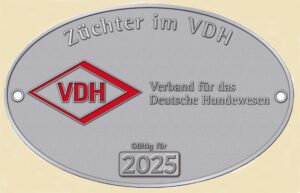Breedstandard
FCI-Standard Nr. 87/13.09.2004/D (in Auszügen)
Katalanischer Schäferhund
(Perro de Pastor Catalán / Gos d’ Atura Catalá)
TRANSLATION : Mrs . Peggy Davis.
ORIGIN : Spain, Catalonia.
DATE OF PUBLICATION OF THE ORIGINAL VALID STANDARD : 26.05.1982.
UTILIZATION :It is in the driving of flocks that the true essence of this breed manifests itself, because not only does he obey the shepherd, but in numerous cases, he shows his initiative, directing the flock with marvellous ease, preventing any animal from separating from the others. Through his great bravery and courage, he can also be used for guarding missions. Because of his size, his beautiful coat, his intelligence and his great loyalty to his masters, he can be an excellent companion.
CLASSIFICATION F.C.I.: Group1Sheepdogs and Cattle Dogs (except Swiss Cattle Dogs).
Section 1Sheepdogs. Without working trial.
BRIEF HISTORICAL SUMMARY : Originates from the Catalonian Pyrenees, has propagated in all other pastoral zones of Catalonia.et.
GENERAL APPEARANCE : Of well balanced medium proportion, medium size, with a beautiful coat.Slightly longer than high, approximately in proportion of 9 to 8.
BEHAVIOUR / TEMPERAMENT : A very sedate dog, active and intelligent, with a noble expression, with a hardy and pleasant character, really devoted to the shepherd and flocks entrusted to him, wary of strangers, which at times make him seem unsociable.
He is very vigilant, very resistant to heat, cold and all atmospherics. A very frugal alimentation is sufficient for him to work in extreme conditions.
COAT : HAIR : Long, flat, or very slightly wavy, rough with abundant undercoat on the whole of the posterior third of the body. On the head we notice a beard, moustaches, tuft and eyebrows which do not affect the sight. Tail well covered with hair as are all the extremities.
It is noticeable that during the moult we observe a typical phenomenon : the moult occurs in two times. First of all it affects the coat on the front part, giving the impression of two halves of dogs with different coats; then it is the turn of the hind part of the dog and everything becomes uniform again.
COLOUR : Seen from the distance the dog seems to be unicolour and may have lighter shadings at the extremities. Seen close up, it is noticeable that the colour comes from the mixture of hairs of different tones : fawn, brown more or less reddish, grey, black and white. The basic colours deriving from this mixture are :
·Fawn, in its light tones, medium or dark.
·Sable, with chestnut hairs, fawn, white and black, also in its light tones, medium and dark.
·Grey, made up of white, grey and black with shadings going from silver grey to blackgrey. If black is dominant and is simply combined with white, it gives a black which looks frosty.
There are also dogs with a mixture of black, fawn and reddish brown, which can dominate in one or several parts, giving the impression of black and tan subjects.
Not admitted are white or black spots. Sometimes a few white hairs, as a star shape on the chest are tolerated, or on the upper part of the toes, but, in that case however, this must not be accompanied by white nails.
SIZE: Height at withers : From 47 to 55 cm for dogs.
From 45 to 53 cm for bitches.
The FCI-Standard you can download by FCI
